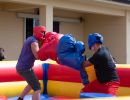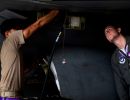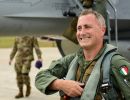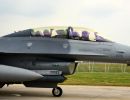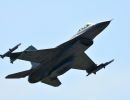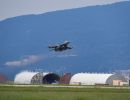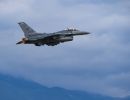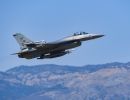F-16 Combat Search and Rescue
Stout, Lans. Code One: Oct 2001. Vol. 16 No.3: Pg ?-?.
This article appeared in the Third Quarter 2001 issue of Code One Magazine.
 Combat Search And Rescue (CSAR) missions usually fall under the control of an Air Force A-10 pilot, who communicates with the downed aircrew and directs helicopters and other assets to the rescue site. F-16 pilots have been called on to perform CSAR missions, too, most recently during Operation Allied Force where circumstances pressed them into action on short notice: They were in the vicinity of the downed pilot, and they were armed with the weapons, communication, and navigation capabilities needed to deal with the situation.
Combat Search And Rescue (CSAR) missions usually fall under the control of an Air Force A-10 pilot, who communicates with the downed aircrew and directs helicopters and other assets to the rescue site. F-16 pilots have been called on to perform CSAR missions, too, most recently during Operation Allied Force where circumstances pressed them into action on short notice: They were in the vicinity of the downed pilot, and they were armed with the weapons, communication, and navigation capabilities needed to deal with the situation.
The CSAR mission became a formal assignment for the F-16 earlier this year as a result of Aerospace Expeditionary Force rotations and the lack of dedicated search and rescue aircraft. Three USAF F-16 squadrons now perform CSAR as part of their regular AEF assignments—the 510th and 555th at Aviano Air Base in Italy and the 18th at Eielson AFB in Alaska.
 “We started working the details for the mission last September,” says Lt. Col. Steve Schrader, commander of Aviano’s 510th Fighter Squadron. “We flew our first CSAR training missions with the 83rd Search and Rescue Squadron of the Italian Air Force in November and again in early February. The 83rd flies HH-3F helicopters from Rimini Air Base.”
“We started working the details for the mission last September,” says Lt. Col. Steve Schrader, commander of Aviano’s 510th Fighter Squadron. “We flew our first CSAR training missions with the 83rd Search and Rescue Squadron of the Italian Air Force in November and again in early February. The 83rd flies HH-3F helicopters from Rimini Air Base.”
In March, members of the 510th deployed to Tyndall AFB in Florida to practice CSAR missions with HH-60G helicopters of the 41st Rescue Squadron “Jolly Greens” from Moody AFB in Georgia. Called Panhandle Rescue 2001, the exercise involved HC-130s, Joint Stars, and AWACS aircraft as well as four F-16s from Aviano.
“Ideally, we will have a complete package of command and control assets, including AWACS, Rivet Joint, Joint Stars, and Compass Call,” says Maj. Mark Moore, an F-16 pilot with the 510th. “E-3 AWACS aircraft direct the entire operation. RC-135 Rivet Joint aircraft monitor electronic activities of potential threats. E-8C Joint Stars helps us track ground targets. EC-130H Compass Call aircraft provide electronic jamming support. That command and control package gives us a lot of situational awareness.”
 Coordination with these other assets, unpredictable movements of potential ground and air threats, variations in terrain, time constraints, and weather and light conditions are a few of the many factors that make training for CSAR missions inherently complex. “To fly out, locate a survivor, build a game plan, bring the assets together, and extract the survivor can be a lengthy process,” explains Schrader. “The mission can take anywhere from two to six hours, even longer depending on the scenario.
Coordination with these other assets, unpredictable movements of potential ground and air threats, variations in terrain, time constraints, and weather and light conditions are a few of the many factors that make training for CSAR missions inherently complex. “To fly out, locate a survivor, build a game plan, bring the assets together, and extract the survivor can be a lengthy process,” explains Schrader. “The mission can take anywhere from two to six hours, even longer depending on the scenario.
“The CSAR mission is also known as a ‘Sandy’ mission from the call signs used for it during the Vietnam War,” Schrader continues. “It normally involves a four-ship of F-16s. Sandy 1, the lead F-16, and Sandy 2 form the lead element. They find the survivor and suppress any threats in the immediate vicinity. Sandy 1 orchestrates the whole scenario. He positions the SEAD assets (suppression of enemy air defense), the electronic warfare assets, and the air-to-air assets. Sandy 2 helps out with communications and situational awareness. Sandy 1 then devises a game plan for getting the aircrew out. Sandy 3 and Sandy 4 rendezvous with the helicopter and escort it to the rescue area. Their job is to sweep the route for surface threats, providing reconnaissance and suppressing ground threats. They also pass information to the lead element.”
The typical loading for the F-16 in the CSAR mission consists of four laser-guided 500-pound bombs, four air-to-air missiles, a LANTIRN targeting pod, an electronic countermeasure pod, and two wing tanks.
 “The F-16 is well-suited for the mission,” notes Moore. “It can get to the area fast and provide for its own self-defense. The radar can find helicopters and other assets involved in the mission. The LANTIRN pod, though it’s designed to deliver laser-guided bombs precisely to a target, allows us to locate the survivor and keep track of things on the ground and in the air. We use the targeting pod to lock onto the rescue helicopter and to keep track of it. Our night vision capability comes in handy. The avionics of the Block 40 F-16, bred for the close air support role, work nicely for CSAR as well.”
“The F-16 is well-suited for the mission,” notes Moore. “It can get to the area fast and provide for its own self-defense. The radar can find helicopters and other assets involved in the mission. The LANTIRN pod, though it’s designed to deliver laser-guided bombs precisely to a target, allows us to locate the survivor and keep track of things on the ground and in the air. We use the targeting pod to lock onto the rescue helicopter and to keep track of it. Our night vision capability comes in handy. The avionics of the Block 40 F-16, bred for the close air support role, work nicely for CSAR as well.”
Aside from avionics, pilot proficiencies developed in close air support and forward air controller missions apply to the CSAR mission. “In CAS and FAC missions,” Moore explains, “we use the targeting pod and our eyeballs to find targets. In many cases, we are relying on someone else to talk us onto a target. We have to develop the ability to translate someone’s visual description of an area from a ground perspective to the LANTIRN’s infrared image of an area from an aerial perspective. That ability to shift perspectives is extremely valuable for the CSAR mission as well.”
 The 510th will soon put its experience and CSAR training to the test later this year when it deploys to Operation Northern Watch. “F-16 CSAR assets will be imbedded in ONW packages for the first time, and we will be the first F-16 unit to support the CSAR mission at ONW,” Schrader proudly notes.
The 510th will soon put its experience and CSAR training to the test later this year when it deploys to Operation Northern Watch. “F-16 CSAR assets will be imbedded in ONW packages for the first time, and we will be the first F-16 unit to support the CSAR mission at ONW,” Schrader proudly notes.
“CSAR is a gratifying mission,” adds Capt. Curtis Pitts, another F-16 pilot in the 510th. “We’re out there saving someone, most likely one of our fellow pilots. The role is very demanding. It’s another hat for F-16 pilots to wear. Frankly, it’s a role most pilots hope they never have to perform. If I ever get shot down, heaven forbid, CSAR is the one mission I want the Air Force to perform at its best.”
Lans Stout is an aviation photographer based in Florida.

 US and allied pilots have flown thousands of combat missions over hostile territory since the Gulf War. The missions continue in Operations Northern Watch and Southern Watch over Iraq, where pilots face surface-to-air missiles and anti-aircraft artillery. They also deal with similar threats over the former Yugoslavia, though to a lesser degree. Despite these constant threats, aircraft losses to hostile fire in these operations can be counted on one hand, thanks to intricate planning, substantial experience, and advanced hardware. If the worst case happens, however, and an aircraft goes down, a combat search and rescue mission kicks into high gear to extract the aircrew from hostile territory quickly and safely.
US and allied pilots have flown thousands of combat missions over hostile territory since the Gulf War. The missions continue in Operations Northern Watch and Southern Watch over Iraq, where pilots face surface-to-air missiles and anti-aircraft artillery. They also deal with similar threats over the former Yugoslavia, though to a lesser degree. Despite these constant threats, aircraft losses to hostile fire in these operations can be counted on one hand, thanks to intricate planning, substantial experience, and advanced hardware. If the worst case happens, however, and an aircraft goes down, a combat search and rescue mission kicks into high gear to extract the aircrew from hostile territory quickly and safely.



























